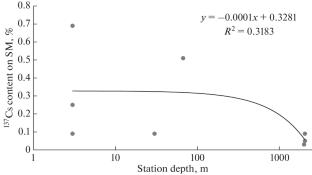Abstract—Sedimentation transport of 137Cs can lead to the significant accumulation of this radionuclide at depths that could not be reached through the vertical water exchange alone; therefore, a comparative assessment of its contents for different types of suspended matter (SM) and regions of the Black Sea is of particular interest. For this purpose, we have collected samples of SM and seawater at deep-water and coastal stations for the subsequent determination of the 137Cs activity in the surface water layer. To calculate the fraction of lithogenic matter, the potassium content in the SM was additionally determined. The range of 137Cs content on SM at different stations differed by more than an order of magnitude: from 7 to 111 Bq/kg for specific activity, and from 0.03 to 0.69% for its content on SM, in % of the total content in the surface water layer. Stations located farther away from the coast were characterized by the lowest percentage of 137Cs in SM, while its content at the coastal stations was more variable. The comparison of the lithogenic and biogenic contribution to SM and data on 137Cs for different stations suggests that the content of this radionuclide on SM is primarily determined by the dynamic variations of the lithogenic matter. Based on the 137Cs migration on SM, the Black Sea is divided into at least two types of regions. One regions are water areas far removed from sources of lithogenic matter where SM is formed mainly due to the hydrobiont activity. The 137Cs content in SM due to the predominance of biogenic matter and an insignificant concentration of lithogenic matter in this case accounts for hundredths of a percent of its total content in the surface water layer. Other regions are coastal and shelf water basins, which, on the one hand, are subjected to the significant coastal and river lithogenic runoff, and on the other, they are characterized by the elevated trophicity and biological productivity. In these water areas, 137Cs content on SM owing to the variability of biotic and abiotic factors is more variable and can fluctuate from values typical for the open sea to an order of magnitude higher.



